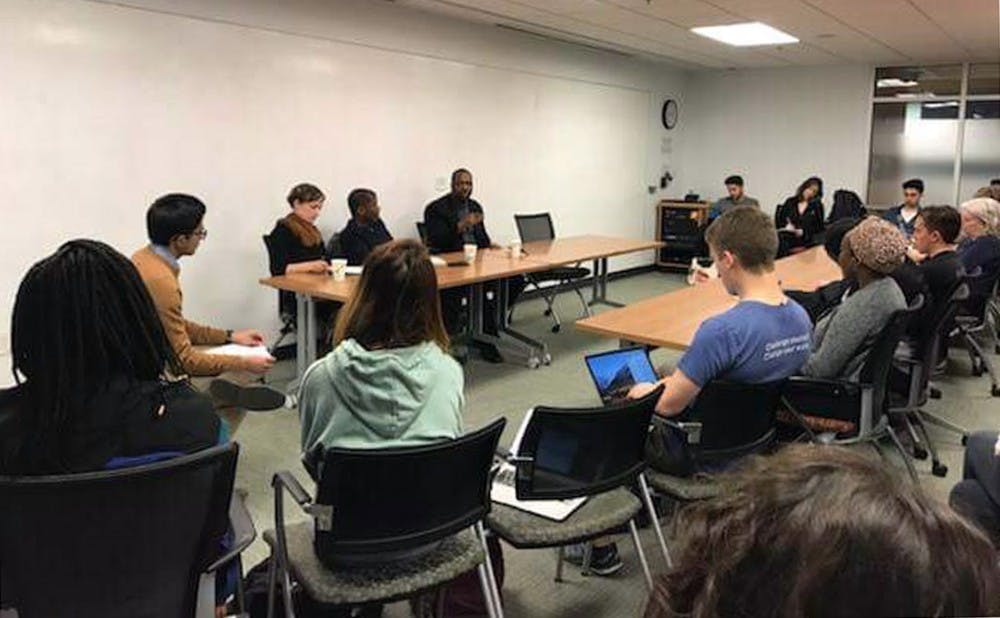A panel of Durham community leaders discussed Monday night the history of affordable housing in the city and how Duke and students can help improve Durham's current housing availability.
The talk, "Highways, Housing and Human Rights: Durham Past and Present" in Gross Hall focused on the history of African American economics in Durham as well as recent urban planning practices that have helped gentrify downtown. The speakers noted that Duke has had a significant impact on the evolution of Durham and its housing availability.
“When I think about the history of housing in Durham, I think about the initial enclaves which developed…primarily African American and White,” said Henry McKoy, director of entrepreneurship at North Carolina Central University.
McKoy, who is originally from Fayetteville, N.C., would come up to Durham frequently when he was kid because his mom’s best friend lived there. McKoy remembers thinking as a child that Durham was one of the dirtiest and grimiest places he had ever visited.
“I mention this because I have now lived in Durham for 20 years and love the city…but growing up, I’d never seen other parts of Durham besides the projects,” McKoy said.
Despite Durham’s incredible diversity, McKoy is tuned in to the fact that the city still grapples with gross inequalities today.
Melissa Norton, project director of the public history project “Bull City 150: Reckoning with Durham’s Past to Build a More Equitable Future,” added that the more she learns about the history of housing and land inequality, the more clear it is to her that the playing field has never been equal.
“It’s written in this country’s DNA,” Norton said.
When the federal government started to get into the housing business after the Great Depression, the government went out and assessed risk in cities across the country to decipher the good and bad places for them to lend money. Through a process called redlining, housing agencies drew red lines in places they would not lend money to, deeming them too high a risk.
“The red lines drawn in Durham were essentially a racial map of the city. Everywhere where black folks lived were deemed unstable,” Norton said.
Since owning a home is the primary way people build wealth in this country, redlining had detrimental effects in Durham. Instead of loans, African Americans got public housing.
M. Keith Daniel, owner of Madison Consulting Group, LLC, explained that he can feel the inequality in his DNA. Despite growing up in Washington, Daniel spent summers in Durham with his extended family and thought of Durham as home prior to attending Duke for his undergraduate degree. Daniel said his experience of Durham was predominately in the black community.
“My lens is from seeing family and friends living in these project areas who also appreciated the gift of our community and how our community was knit together even though we were living in housing which was less than ideal,” Daniel said.
It’s amazing to see how much has changed and how much has not changed at the same time, he added
You can’t talk about the reemergence of downtown Durham without talking about Duke," McKoy said. When Duke was rapidly growing and aspired to be the Harvard of the South, it started investing in Downtown Durham.
However, despite Duke’s investments, the speakers noted that downtown Durham never reconnected to the African American ecosystem as it had done extensively before during the time of Durham's black wall street. So as downtown Durham reemerged, it did very little to help the African American community. Today, there are only three African American owned business in downtown Durham, McKoy said.
Norton, on the other hand, highlighted Duke’s flaws in terms of its relationship within the Durham community.
“I have a friend who likes to say that Durham is still a factory town, and Duke is the factory,” Norton said.
She noted that Duke not only needs to pay more in property taxes as most other prestigious universities do and also needs to pay its workers a legit living wage. If Duke paid all of its property taxes, it would be paying 8.8 million yearly, she said.
“Duke gives to the Durham community, but it does so on its own terms," she said. "It’s a self-interested institution, and I have the receipts to back that up."
As for the future of Durham, McKoy explained that there is a lot of tension in the city because it’s growing at such a fast pace in terms of population size and the number of businesses.
“This is putting a lot of pressure on housing because things need to be developed incredibly quickly,” McKoy said. “Who will benefit from the future of Durham as it goes through this growth spurt?”
Daniels said a key challenge in making positive progress is the lack of interaction between folks living in the community and folks in positions of power who make key decisions. But he's hopeful about the city's future.
“The gift here is that we have a history of some breakthroughs and a lot of good folks still trying to put their heads, hearts and minds together in this concern for economic justice,” Daniels said.
Get The Chronicle straight to your inbox
Signup for our weekly newsletter. Cancel at any time.

